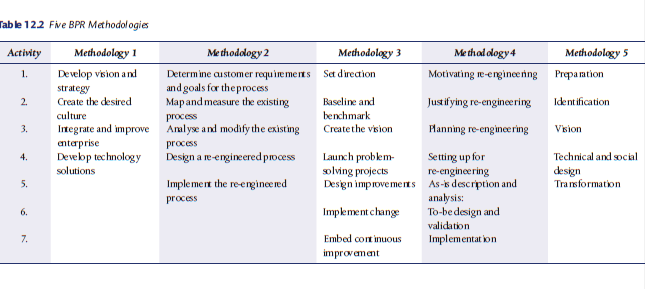A consolidated methodology was developed in 1999 by Subramanian Muthu, Larry Whitman and S. Hossein Cheraghi based on the five methodologies given below: 5
Methodology 1: Underdown (1997)
Methodology 2: Harrison and Pratt (1993)
Methodology 3: Furey (1993)
Methodology 4: Mayer and Dewitte (1998)
Methodology 5: Manganelli and Klien (1994)
The five sets of methodologies have been summarized in Table 12.2.
The consolidated methodology comprises the five activities discussed below:
1. Activity 1: Prepare for Re-engineering
Before planning for re-engineering, there should be a significant need for the process to be re-engineered. The justification of this need marks the beginning of the preparation activity. This activity begins with the development of executive consensus on the importance of re-engineering and the link between business goals and re-engineering projects. The various steps needed to prepare for re-engineering are:
- Building cross-functional teams
- Identifying customer-driven objectives
- Developing strategic purpose
2. Activity 2: Map and Analyse the As-Is Process
The team should understand the existing process before initiating the re-engineering process. Re-engineers need to map the existing processes first and analyse and improve on it to design new processes. An important objective of BPR is that improvement efforts should provide dramatic results. The main objective of this phase is to identify disconnects (anything that prevents the process from achieving desired results) and value adding processes. The various steps needed to map and analyse an as-is process are:
- Create activity models
- Create process models
- Simulate and perform activity-based costing
- Identify disconnects and value adding processes
3. Activity 3: Design the To-Be Processes
This activity is an iterative process and cannot be done overnight. The objective of this activity is to produce one or more alternatives to the current situation. Simulation and activity- based costing is conducted to analyse factors like time and cost involved as in the case of the as-is model. The various steps needed to create the design to-be process are:
- Benchmark processes
- Design to-be processes
- Validate to-be processes
- Perform trade-off analysis
The benchmarking process deals with comparing the performance of the organization’s processes and the way those processes are conducted with those relevant to the peer organization. This is undertaken to obtain ideas for improvement. The peer organization may be any organization from which innovative practices can be adopted. After having identified the potential improvements to the existing processes, the development of the to-be model is done using the various available modeling methods. The several to-be models that are arrived finally are validated. Trade-off analysis now enables the best possible to-be scenarios that can be selected for implementation.

4. Activity 4: Implement Re-engineered Process
At this stage, re-engineering efforts meet the most resistance from people and; hence, this is the most difficult activity. However, the cultural change programme should be rooted in the minds of everyone involved in the BPR project. This is vital for the success of this effort. The various steps involved in implementing the re-engineered processes are:
- Evolve implementation plan
- Prototype and simulate transition plans
- Initiate training programmes
- Implement transition plan
5. Activity 5: Improve Process Continuously
The process must be improved continuously in order to ensure the success of the reengineering efforts. The first step in this activity is to monitor the new process. The progress of actions and the results of the process have to be monitored. The progress of action is measured by studying how much more informed the people are, how much extra commitment the management provides and how well the BPR teams are expected to perform in the broader perspective of the re-engineering process. The monitoring of results should include measures such as customer perceptions, employee attitudes, supplier responsiveness, etc. Communication should be reinforced throughout the re-engineering process when the ongoing measurement is initiated, the team review of the performance against clearly defined targets is carried out and a feedback loop is setup in which the process is re-mapped, redesigned and reanalysed. The continuous improvement of performance is ensured thorough a performance tracking system and using problem-solving techniques. The various steps involved in improving the continuous process are:
- Initiate ongoing measurement
- Review performance against target
- Improve process continuously
TQM and BPR have always been considered complementary to each other. TQM can be used as a continuous improvement tool to handle the various problems encountered during the BPR initiatives and to continuously improve the process.
Source: Poornima M. Charantimath (2017), Total Quality Management, Pearson; 3rd edition.

17 Jul 2021
17 Jul 2021
1 Jun 2021
17 Jul 2021
4 Jan 2018
1 Jun 2021